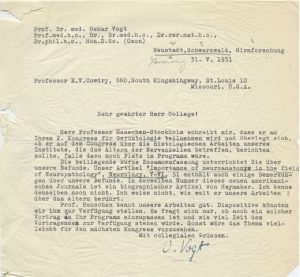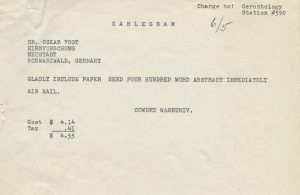Cecile and Oskar Vogt and their circle examine illustrations, 1903, in photo taken in Berlin, from Vogt Archiv, University of Düsseldorf.
In this photo from the Vogt Archiv now at the University of Dusseldorf, Cécile and Oskar Vogt sit and examine a set of plates. Korbinian Brodmann, Max Borchert and Max Lewandowsky, their close collaborators, stand around them.The woman standing behind Oskar Vogt is unidentified.
My source for information on the Vogts and their publications is the biobibliographical introduction to: Miloš Judaš, Maja Cepanec (2010), “Oskar Vogt: the firstmyeloarchitectonic map of the human frontal cortex,” Translational Neuroscience • 1(1) pages 72–94. This English translation of Oskar Vogt's 1910 paper and a biobibliography was an attempt to bring Oskar's work and Cecile's to the attention of modern English-speaking audiences.
Cécile Mugnier and Oscar Vogt
Cécile Mugnier and Oscar Vogt met in Paris in 1897. Cécile Mugnier, born in 1875 in Annecy, France, was the student of Pierre Marie. She came to the Faculté of Medicine to study medicine in 1893 at 18. In spite her family’s objection to a career in medicine, she earned her M.D in 1897. In her thesis with Pierre Marie, Cécile Mugnier investigated the myelinzation of cerebral hemispheres. She was probably the first female graduate to study neuropathology. (Miloš Judaš, Maja Cepanec (2010)).
Oskar Vogt was born in 1870 in Husum, Schleswig-Holstein. After beginning university at Kiel University he transferred in 1890 to the medical faculty of the University of Jena, where he was influenced by evolutionary teachings of Ernst Haeckel and Otto Binswanger, chief of the university psychiatric clinic who believed that mental disorders had an anatomical basis. After graduating as a physician in 1893 and earning his M.D. (1894), he worked for a year at Binswanger’s clinic. But he moved to the Burgholzli psychiatric hospital in Zurich to study with August Forel. The collaboration turned into a life-long friendship. In 1896, Vogt accepted a position in Alexandersbad in the Spruce Mountains region and there he became a friend and personal physician of munitions manufacturer, Friedrich Alfred Krupp. At Alexandersbad, he also met the physician Korbinian Brodmann, who became a valuable research collaborator. At the beginning of 1897, Oskar came to Paris to study with Jules Dejerine and Augusta Klumpke Dejerine, who led laboratory neighboring that of Pierre Marie. Soon he met Marie’s student, Cécile Mugnier. They married in Paris in 1899 and throughout his career, Cécile was his best and closest collaborator. (Miloš Judaš, Maja Cepanec (2010)).
Oskar and Cécile moved to Berlin, started a private practice and established an independent brain research laboratory. K. Brodmann joined them in 1901 and Max Bielschowsky did so in 1904. This group developed their research program which led to the birth of modern archtectonics of the cerebral cortex. In 1902 the laboratory, still located at their apartment, became administratively attached to the Physiological Institute of Berlin University. (Miloš Judaš, Maja Cepanec (2010)).
Cecile and Oskar Vogt’s Publications in the Bernard Becker Medical Library
Oskar and Cécile Vogt edited three journal titles that succeeded one another and our library has all three journals. Oskar Vogt started editorial work with his mentor August Forel in a journal that we don't own, Zeitschrift für Hypnotismus. In 1902 Forel and Oskar Vogt broadened their journal’s focus with a new title, Journal für Psychologie und Neurologie, Band I. This journal continued until 1942 and published many of Cécile and Oskar’s articles and monographs and those of their students and collaborators. In 1951, they began again as Journal der Hirnforschung (Brain Research) and this German language journal included English and French summaries starting in 1954. When the language of the journal changed from German to English in 1994, the title became Journal of Brain Research. Journal of Brain Research went out of existence in 1999. Journal für Psychologie und Neurologie is in the the lower level of Becker Library (Compact Shelving). The later titles are on Level 3 but will soon be in offsite storage.
Archives and Rare Books on level 7 has four rare book-length works by Cecille and Oskar Vogt. The earliest and most beautiful is their joint monograph on the myelination in the human infant brain which they published in Neurobiologische Arbeiten, Series 1, 1902-1904 (Miloš Judaš, Maja Cepanec (2010)). Becker library has two copies of Vogt's 4 volume monograph on human myelination with its beautiful collotype microphotographic plates. Cecile Vogt initially studied myelinization in cats (1898) and the myeloarchitectonics of the monkey thalamus with Pierre Marie (1900). As Oskar began his research career with myelogenetic studies published in 1895-1906, this common interest led to their joint study of Human myelination (1902-1904).
Archives and Rare Books on level 7 also has series 2 of Neurobiologische Arbeiten with monographs by Vogt’s friends and collaborators, Max Lewandowsky and Max Borchert.
Cécile and Oskar Vogt’s most cited monograph, Allgemeine Ergebnisse unserer Hirnforschung is the most detailed exposition of Oskar’s myeloarchitectonic mapping of the entire cerebral cortex. It was published in Journal für Psychologie und Neurologie in 1919, but it is also cataloged separately in rare books on level 7. Another rare monograph published in Journal für Psychologie und Neurologie in 1925, is also on level 7. In Erkrankungen der Grosshirnrinde im lichte der Topistik, Pathoklise und Pathoarchitektonik, Cécile and Oskar Vogt present their findings on the extrapyramidal system and its pathology.
 Correspondence between Oskar Vogt and E.V. Cowdry in the Cowdry Papers, Bernard Becker Medical Library Archives
Correspondence between Oskar Vogt and E.V. Cowdry in the Cowdry Papers, Bernard Becker Medical Library Archives 
On May 31, 1951, Oskar Vogt wrote a letter in German to E.V. Cowdry, at Washington University School of Medicine. At that time, Cowdry was organizing a Second International Gerontological Congress which was held in St. Louis, MO on September 8-14, 1951. Oskar asked if there was room on the program to report the work of their institute on the aging of nerve cells. Cowdry said yes and asked for a 400 word abstract. All three letters are available here.
Bibliography
Journal für Psychologie und Neurologie, Band 1-40, Leipzig: Verlag von Johann Ambrosius Barth, 1902-1942. Becker Library catalog: http://beckercat.wustl.edu/cgi-bin/koha/opac-detail.pl?biblionumber=98335 Online at HathiTrust: https://catalog.hathitrust.org/Record/000051600?type[]=title&lookfor[]=Journal%20fur%20Psychologie%20und%20Neurologie&ft=
Miloš Judaš, Maja Cepanec (2010), “Oskar Vogt: the firstmyeloarchitectonic map of the human frontal cortex”,Translational Neuroscience • 1(1) • 2010 • 72–94
Olszewski, Jerzy M.D, "Cécile and Oskar Vogt," Archives of Neurology & Psychiatry, Vol 64, No. 6, pages 815-818 (December 1, 1950)
Oskar Vogt correspondence, Box 90, Folder 16, E. V. Cowdry Papers, Bernard Becker Medical Library Archives, Washington University School of Medicine.

